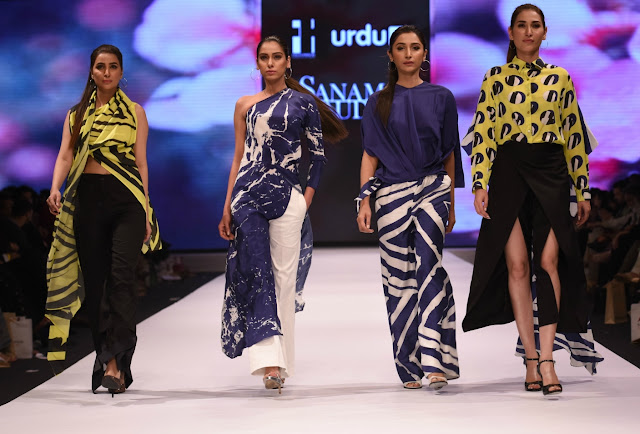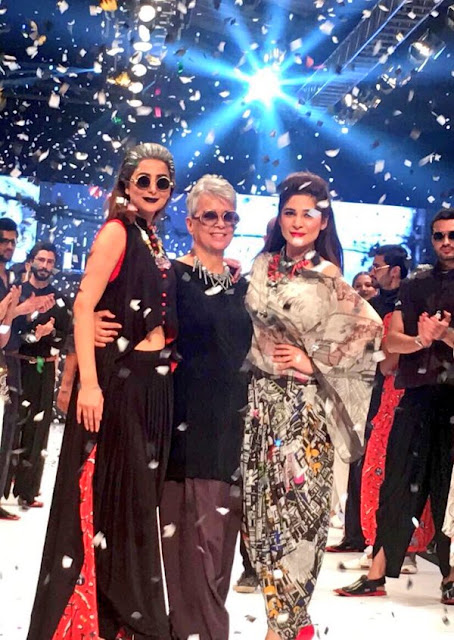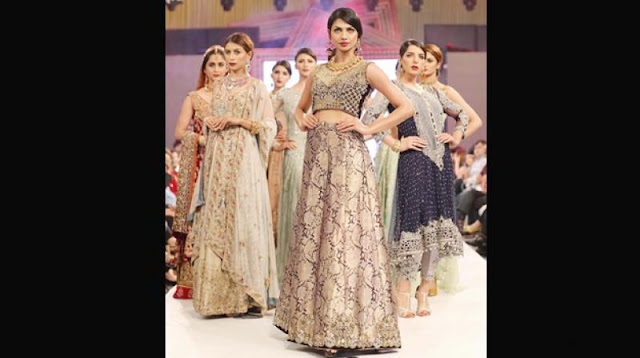PakAlumni Worldwide: The Global Social Network
The Global Social Network
Fashion Pakistan Week 2016 in Karachi
Here are a few pictures from the fashion show:
Photos Couresy of Tapu Jhaveri, others.
Here's a Pakistan Pictorial:
Find more photos like this on PakAlumni Worldwide: The Global Social Network
Related Links:
Haq's Musings
Pakistan Fashion Shows
Pakistani Village Girl Launches VC-Funded Fashion Startup in San Fr...
Pakistan's Top Fashion Models
Pakistani Cover Girls
Life Goes On in Pakistan
Pakistan Fashion Week 2013
Karachi Fashion Week 2013
Veena Malik Challenges Pakistan's Orthodoxy
PakAlumni-Pakistani Social Network
Huma Abedin Weinergate
Pakistan Media Revolution
Protest Music in Pakistan
Resilient Pakistan Defies Doomsayers
Life Goes On in Pakistan
Pakistani Entrepreneurs Survive Economic Downturn
Silent Social Revolution in Pakistan
-
Comment by Riaz Haq on April 9, 2016 at 12:53pm
-
Compliment from #India: "quality and finesse of #Pakistani embroidery can outshine their Indian counterparts" #FPW16 http://www.deccanchronicle.com/lifestyle/fashion-and-beauty/100416/... …
Prasad Bidapa, who was in Pakistan for a fashion show, loved the trends and styles sported by the gorgeous Pakistanis.
We have long known that the quality and finesse of Pakistani embroidery can outshine their Indian counterparts, especially in the bridal segment. Their colour palettes are muted and the designers balance tradition with modernity across their lovely collections.
The models are truly gorgeous and some of them are truly one of the greatest beauties I have ever seen. Getting to work with leading Pakistani designers at Huma Nassr’s Shaan-e-Pakistan was a fascinating experience. The trends that I witnessed with the designers were an eclectic blend of couture and also concentration on pret versions of ethnic styles.
http://www.deccanchronicle.com/lifestyle/fashion-and-beauty/100416/...
-
Comment by Riaz Haq on June 6, 2016 at 7:30am
-
BBC News - #Pakistan fashion enters #London spotlight with new #EidCollection http://www.bbc.com/news/world-asia-36457131Dozens of Pakistani designers have been showcasing their latest trends in a Pakistan Fashion Week event in London.Hundreds attended the two day event, spending thousands of pounds on the latest trends ahead of the Muslim festival of Eid next month.
-
Comment by Riaz Haq on November 1, 2016 at 8:46pm
-
Muktaran Mai, gang-rape victim, now walks the #fashion runway at #fpw2016 in #Karachi #PakistanIn 2002, Mai was sentenced by a local council of tribal elders to be gang raped and publicly humiliated as punishment for her brother’s perceived insult to a rival family. The Associated Press does not identify victims of sexual assault unless they choose to identify themselves.Rather than commit suicide, as many Pakistani women in her position have done, Mai went public and fought all the way to the country’s Supreme Court to have her attackers jailed.Fourteen men - the alleged rapists and the tribal council members - were put on trial, and six were handed the death sentence. But all of them were eventually released on appeal.Nevertheless, Mai went on to become an international advocate for women’s rights and founded a charity that sponsors a women’s shelter and a girl’s school in her rural hometown of Meerwala.On Tuesday night, surrounded by Pakistan’s top models and wealthy designers, Mai appeared slightly shy and nervous when faced with the blitz of cameras. Mai, now 44, wore a light green embroidered bridal shirt and silver, silk pajama pants, designed by Rozina Munib, with a scarf covering her hair.Munib said she approached Mai to display her designs to send a public message that, “If you have a mishap, it’s not the end of life.”Mai smiled as she walked the runway along with several other models in the concluding event of the three-day Fashion Pakistan Week event. Afterward she moved around freely through the crowds, chatting with well-wishers and allowing a steady stream of admirers to take selfies with her.The annual fashion showcase was started in 2009 in defiance to religious fundamentalists in Pakistan who sought to enforce strict dress codes and behavioral restrictions on Pakistani women.“I want to be the voice of those women who face circumstances similar to what I did,” Mai said. “My message for my sisters is that we aren’t weak. We have a heart and a brain, we also think.”“I ask my sisters to not lose hope in the face of injustice, as we will get justice one day for sure.”
-
Comment by Riaz Haq on September 25, 2017 at 8:19pm
-
#Pakistan’s first #global #fashion billionaire? #Khaadi #Karachi #textiles #rmg #garments https://profit.pakistantoday.com.pk/2017/09/25/pakistans-first-fash... … via @profitpk
The year 2017 is the first time the Pakistani clothing market hit Rs1 trillion in consumer spending (according to an analysis conducted by Profit based on data from the Household Integrated Economic Surveys, published by the Pakistan Bureau of Statistics). It is also the year the biggest brand in the industry – Khaadi – learnt about both the benefits and the costs of being the market leader, with a very public labour dispute and a string of negative stories published about it in the print media.
In the nearly two decades it has existed, Khaadi has gone from being a small store on the corner of a narrow street in Karachi’s Zamzama commercial area to become the industry-defining brand in Pakistan’s retail fashion sector. On the way, it has created, expanded, and conquered market that was virtually nonexistent prior to Khaadi’s launch in December 1999. Yet even as it stands as the clear champion of a rapidly growing market, Khaadi’s future has never been more precarious. In the next year or two, the actions of Khaadi’s management, particularly founder and CEO Shamoon Sultan, will determine whether it becomes a true national (and possibly global) corporate icon, or whether it will wither and fade away into obscurity.
While Khaadi clearly started as a passion project focused on selling khaddar clothing, it did not stay that way for long. Shamoon and Saira may have an artistic passion for the products they create, but they are clearly commercially focused as well, launching women’s clothing lines, pret, and lawn. The company sells both readymade garments and unstitched fabric.
The company began expanding its presence, first within Karachi, then on to Lahore and Islamabad, followed by eight other cities across Pakistan. By 2010, Khaadi felt confident enough to make its first foray into international retail, setting up a in Dubai, followed quickly by a store in Abu Dhabi. In 2013, Khaadi began opening stores in the UK.
While Khaadi has been remarkably successful, its success needs to be placed in a broader context: the rise of the Pakistani middle class, specifically the rise of the working woman, who has enabled families to rapidly expand their household incomes and move out of subsistence living and towards a truly consumption-oriented economic existence.
Pakistan’s female labour force participation rates have increased dramatically, from 16.2% in 2001 to 23.4% in 2015, the latest year for which data is available from the Labour Force Survey conducted by the Pakistan Bureau of Statistics. As a result, household incomes have risen to Rs34,707 ($333) per month, according to data from the 2016 Household Integrated Economic Survey. That represents an annualized increase of 9.3% per year over the past 15 years (5.7% in US dollar terms).
The rapid rise in spending on clothing also appears to be causing a shift in patterns of what types of clothes Pakistanis buy. In 2002, according to PBS data, more than 68% of total spending on clothes went to buying unstitched cloth and other accessories and only 13% of spending went to readymade clothes. In 2016, the proportion of consumer spending going to readymade clothes was 33%, with unstitched cloth and accessories going down to 50% of total spending.
Readymade garments are, by far, the fastest growing segment of consumer spending on clothing and footwear, growing at an astonishing 24.2% per year (20.1% in US dollar terms) over the past 15 years to reach a market size of Rs356 billion ($3.4 billion) in fiscal year 2017, according to Profit’s analysis of PBS data. The overall clothing market, as noted at the beginning of this article, has reached Rs1.1 trillion ($10.3 billion) during that same period.
-
Comment by Riaz Haq on November 12, 2019 at 9:37pm
-
How #Pakistan's Chitral region stole the show at #Milan #Fashion Week 2019. Stella showcased her latest Spring/Summer 2020 collection at the event, which incorporates multiple elements from the culture of Chitral and Kalash https://tribune.com.pk/story/2062979/4-chitral-stole-show-milan-fas...
Just last week, Pakistani models Mushk Kaleem and Alicia Khan made headlines for being selected to walk for Haitian-Italian designer Stella Jean at the ongoing Milan Fashion Week.
But that’s not all. Stella showcased her latest Spring/Summer 2020 collection at the event, which incorporates multiple elements from the culture of Chitral and Kalash!
Kaleem opened the show for Jean sporting two looks, and was immensely grateful for the opportunity.
The collection was later featured on Vogue. Jean seems to be on a fashion mission of-sorts, travelling to different parts of the world to discover little-known artisanal traditions.
For her latest collection, the designer travelled to Pakistan where she met with the women of Kalash who specialise in multi-coloured embroideries.
According to Vogue, these local artisans made the 15,748 inches of embroideries that Jean used to in her designs. The handmade embellishments, mixed flowers and geometric shapes, popped up on a flared mini-dress with a voluminous bottom punctuated by eyelet, a kimono-like jacket, a shirt-dress featuring utility pockets and a puffy blouse with a maxi collar.
For two weeks, Jean lived in the remote valleys of Chitral with the Kalash people. There, among a small population of about 3,000, she learned about the embroidery women do to adorn their dresses, a tradition that, much like the Kalash people themselves, is at risk of becoming extinct.
In an effort to raise awareness about the Kalash and to provide their community with income, Jean collaborated with the Chitral Women’s Handicrafts Center, founded by the 22-year-old Karishma Ali, on the collection. For several weeks, 46 women in the center embroidered more than 4,000 meters of material for her.
On the runway inside Milan’s Palazzo Arengario, the colourful stitching wrapped around dresses, adorned belts, and decorated the hemlines of Jean’s summer dresses. It was the first time the embroideries were ever presented for use outside the Kalash community.
-
Comment by Riaz Haq on November 21, 2019 at 2:17pm
-
See #KateMiddleton's Personal Note to Her #Pakistani #Fashion Designer and Élan’s creative director Khadijah Shah, to say thank you. https://people.com/royals/see-kate-middletons-personal-note-to-desi...
Kate Middleton is thanking those who helped her look stylish on her recent tour of Pakistan.
As the royal mom and Prince William boarded a plane back to Islamabad after an unexpected electrical storm changed their flight plans the previous night, she looked glamorous in a black and white embroidered kurti by Pakistani designer label Élan.
Earlier this month, Kate reached out to Élan’s creative director, Khadijah Shah, to say thank you.
“Thank you so much for all of your help ahead of my tour to Pakistan,” the note reads. “I am so grateful to you and your team for the wonderful selection you made for me to chose from — although having so many beautiful things did make the decision making a little more difficult!”
“I loved the outfit I wore, so thank you for all your time and effort,” Kate continued.
Though the body of the message was typed — on custom stationary from Kensington Palace — the royal personalized the note by writing “Dear Khadijah” and signing her full name “Catherine” in cursive.
I was delighted to have even been considered, this is just humbling to a whole different level. However what’s most commendable is the consideration, grace and thoughtfulness of HRH the Duchess Catherine, it is no wonder that she is so respected and beloved @KensingtonRoyal
“I was delighted to have even been considered, this is just humbling to a whole different level,” Shah captioned a photo of the letter on Twitter. “However what’s most commendable is the consideration, grace and thoughtfulness of HRH the Duchess Catherine, it is no wonder that she is so respected and beloved.”
-
Comment by Riaz Haq on March 20, 2020 at 8:08am
-
#China #Pakistan FTA-2: #Pakistan textile #exports to rise to $25 billion in new regional hub. As #coronavirus outbreak puts the globalisation into reverse and challenges existing global value chains, new supply chains continue to form behind the scenes.
https://www.outlookindia.com/website/story/news-analysis-china-paki...
With the second phase of the CPFTA, there is a possibility of relocating the production of international brands, many of which have facilities in China that import cotton fabric from Pakistan as raw material—to Pakistan itself. The inflow of Chinese investment in machinery and technology in order to set up production bases in Pakistan will drive innovation and economies of scale, thereby making Pakistan regionally competitive in cotton-based garments. In addition, Pakistan will garner a favourable position for exporting to other markets that have so far been trading primarily with China as well as potentially to other Regional Comprehensive Economic Partnership (RCEP) members.
---------------
The period from 2009 to 2015 witnessed an increase in direct export of cotton suits from Pakistan to India that peaked in 2015 at USD 247,800 from USD 4,100 in 2009. The growing appetite for Pakistani designs and styles in India also led to the development of a huge parallel industry in India, where manufacturers in Surat, Gujarat took inspiration from the Pakistani designs and patterns and replicated them on to the domestically produced fabrics.
India’s markets got flooded with Pakistani cotton suits – both originals and first copies - for tag-conscious and price-conscious customers respectively. Since the India-Pakistan trade ban in 2019, the supply of these Pakistan-made garments was once again re-routed via Dubai; India imported USD 68,100 of cotton suits via the UAE in 2019, jumping significantly from USD 3,600 in 2018.
While pricier cotton ultimately impacts the consumers of cotton-based garments, re-routing via third country pushes the prices further up. Despite this, the Dubai-angled triangle for trade between India and Pakistan continues to exist as the mechanisms of indirect trade remain more organized than those of direct trade.
The question is what an agreement like CPFTA2 can lead to, given the current circumstances. There can be two scenarios – one, shifting away to sourcing raw material via routes that are not as cost-effective, could hurt Pakistan’s export competitiveness vis-à-vis other trading partners, like China in this case, or two, Pakistan, despite the disruption of cotton supply from India, could manage to produce/source cotton at competitive prices, and emerge as a regional hub for cotton-based garments. The latter is just as likely, if not more.
(Nikita Singla is Associate Director and Priya Arora is a Senior Research Associate at Bureau of Research on Industry and Economic Fundamentals (BRIEF), New Delhi. Priya Arora is a Senior Research Associate at the Bureau of Research on Industry and Economic Fundamentals (BRIEF), New Delhi.)
Comment
Twitter Feed
Live Traffic Feed
Sponsored Links
South Asia Investor Review
Investor Information Blog
Haq's Musings
Riaz Haq's Current Affairs Blog
Please Bookmark This Page!
Blog Posts
Has Pakistan Destroyed India's S-400 Air Defense System at Adampur?
Pakistan claims its air force (PAF) has destroyed India's high-value Russian-made S-400 air defense system (ADS) located at the Indian Air Force (IAF) Adampur air base. India has rejected this claim and posted pictures of Prime Minister Narendra Modi posing in front of its S-400 rocket launchers in Adampur. Meanwhile, there are reports that an Indian S-400 operator, named Rambabu Kumar Singh, was killed at about the time Pakistan claims to have hit it. Pakistan is believed to have targeted…
ContinuePakistan Downs India's French Rafale Fighter Jets in History's Largest Aerial Battle
Pakistan Air Force (PAF) pilots flying Chinese-made J10C fighter jets shot down at least two Indian Air Force's French-made Rafale jets in history's largest ever aerial battle involving over 100 combat aircraft on both sides, according to multiple media reports. India had 72 warplanes on the attack and Pakistan responded with 42 of its own, according to Pakistani military. The Indian government has not yet acknowledged its losses but senior French and US intelligence officials have …
ContinuePosted by Riaz Haq on May 9, 2025 at 11:00am — 32 Comments
© 2025 Created by Riaz Haq.
Powered by
![]()















You need to be a member of PakAlumni Worldwide: The Global Social Network to add comments!
Join PakAlumni Worldwide: The Global Social Network